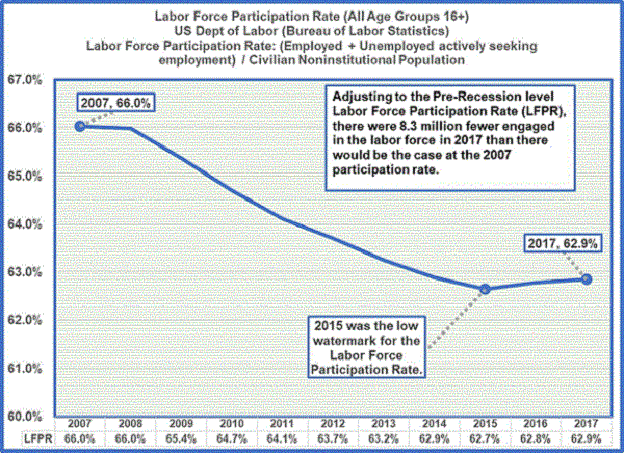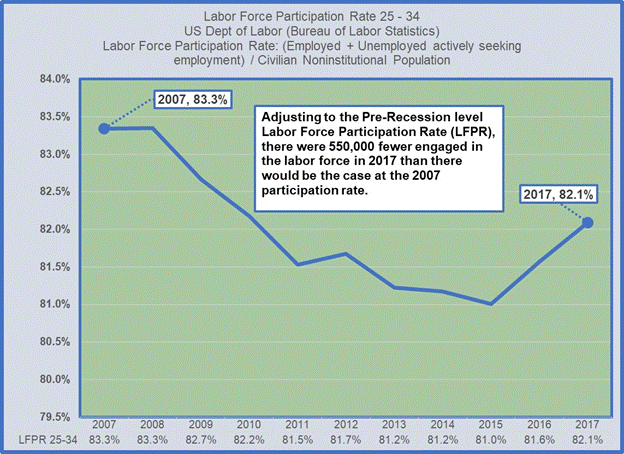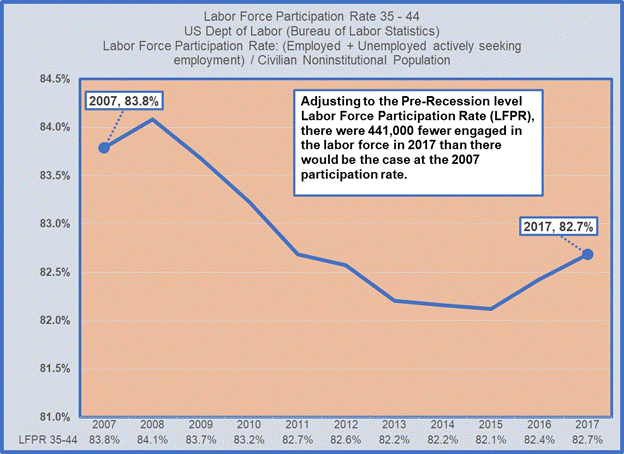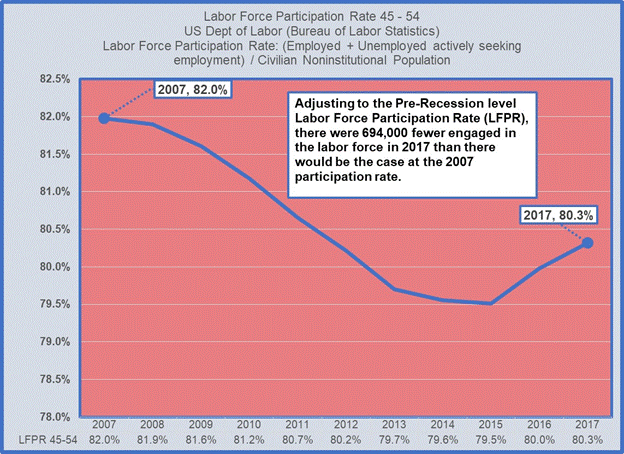2018 Volume Issue 3
Economic Newsletter for the New Millennium August 5, 2018
For a downloadable version, click the following:
…a bit more compressed version of the PDF
The Employment Picture July 2018: The economy continues to grow jobs well beyond the expectations of the conventional wisdom crowd
For the twenty-one-year period from 1988 through 2008, the Labor Force Participation Rate averaged 66.5%. While the current Labor Force Participation Rate of 62.9% in July 2018 has improved from its low of 62.3% in September 2015, it is well off the previous level leading up to the recession ten years ago.
The employment numbers for the month of July, just released by the Department of Labor, Bureau of Labor Statistics, show the following:
Nonfarm Payroll Report (Establishment Survey):
Total nonfarm payroll employment increased by 157,000 in July, compared with an average monthly gain of 203,000 over the prior 12 months. In July, job gains occurred in professional and business services, in manufacturing, and in health care and social assistance.
- Household Survey (Current Population Survey):
- Employed increased by 389,000
- Unemployed dropped by 284,000
- U3 Unemployment Rate fell from 4.0% to 3.9%
- Labor Force Participation Rate (LFPR) remained unchanged at 62.9%
The first question of course is how can one survey show us 157,000 people added to the employment while the other indicates that there were 389,000 added to the employment roles for the month?
Keeping in mind that the Establishment (Payroll) Survey measures about 95% of the Household Survey and seem to be in concert over time:
From the BLS - Bureau of Labor Statistics
Frequently Asked Questions about Employment and Unemployment Estimates
https://www.bls.gov/news.release/empsit.faq.htm
Why are there two monthly measures of employment?
The household survey and establishment survey both produce sample-based estimates of employment, and both have strengths and limitations. The establishment survey employment series has a smaller margin of error on the measurement of month-to-month change than the household survey because of its much larger sample size. An over-the-month employment change of about 100,000 is statistically significant in the establishment survey, while the threshold for a statistically significant change in the household survey is about 500,000.
However, the household survey has a more expansive scope than the establishment survey because it includes self-employed workers whose businesses are unincorporated, unpaid family workers, agricultural workers, and private household workers, who are excluded by the establishment survey. The household survey also provides estimates of employment for demographic groups.
For more information on the differences between the two surveys, please visit
https://www.bls.gov/web/empsit/ces_cps_trends.htm.
Second: How relevant is the U3 Unemployment Rate?
The U3 Unemployment Rate is simply the relationship those that are unemployed (those not employed, but ACTIVELY seeking employment), divided by the Labor Force (Employed + U3 Unemployed). In historical terms, a U3 Unemployment Rate between 4.0% and 5.0% would be considered full employment (or the full employment unemployment rate). Full employment unemployment is simply an expression of an economy that is humming along in an efficient manner. Keep in mind that there is always some unemployment, even in a healthy labor market. This is due to the fact that people might be between employment opportunities (frictional unemployment); not working due to retraining (structural unemployment); or simply due to seasonality such as typically occurs in construction in northern tier states in the winter.
The U3 Unemployment rate dropped to 3.9% in July from 4.0% in June. In addition, the actual number of unemployed fell 284,000. This would indicate a movement in the ranks of the labor force (employed plus U3 unemployed) from the unemployed side to the employed category.
Stepping back a bit, the actual (Civilian) Labor Force number is a subset of the (Civilian) Noninstitutional Population. The Civilian Noninstitutional Population (CNP) consists of the Labor Force (Employed plus the U3 Unemployed) plus the Not in the Labor Force component. The CNP includes all of those individuals 16+ years of age who are in the military, incarcerated, or counted in other institutional situations.
The important thing to note with the not in the labor force component is that it includes retirees and those folks who are otherwise on the sidelines by choice, disabled, and those who have simply given up seeking employment (discouraged workers).
Conventional Wisdom attributes much of the expansion in the ‘not in the labor force' component of the Civilian Noninstitutional Population to Baby Boomers rolling into their retirement years.
Moving forward in this presentation, it is important to understand that again much of the fall-off in the labor force participation rate (LFPR) has been attributed to the increasing numbers of folks from the Baby Boomer years (born 1946 - 1964) moving into their retirement years. The Census Bureau, the group that does the counting for the Bureau of Labor Statistics (BLS) in its Household Survey or Current Population Survey (CPS), presents material in a variety of ways, including age groupings or age cohorts.
The age cohort data is mostly presented on an annual basis. In the following sets of data, we can see the changes in the Labor Participation Rates in the age cohorts over the past several years. It is clear from the data that the younger cohorts have not returned to their pre-recession levels. You should note that while the numbers are rising in the 65+ set as Baby Boomers continue to swell the ranks, they are actually remaining in the labor force at significantly higher rates. Of course, due to the size of the boomer cohorts, they would naturally drive down the overall labor participation rate, but the younger groups should have at least returned to their pre-recession participation rates.
What this means is that there are individuals on the sidelines in the not in the labor force component of the Civilian Noninstitutional Population (CNP) that should and can be encouraged to re-enter the labor force.
In going through the various age cohorts, we simply applied the 2007 Labor Force Participation Rate to the 2017 Civilian Noninstitutional Population age groups.
First, if we overlay the current Labor Force (Employed plus Unemployed) data with the 2007 Labor Force Participation Rate (Labor Force / Civilian Noninstitutional Population), there is an 8.3 million shortfall in terms of the Labor Force. It's interesting to note that it took until 2015 to turn the corner regarding the Labor Force Participation Rate. We have a long way to go to return anywhere near the pre-recession levels.

In drilling down on the various age groups (age cohorts), we can see that there is a 3.2 million shortfall in just focusing on the 16 to 54-year-old segment. You would expect in a legitimate economic recovery for the participation rates to return to the pre-recession levels - if not much higher.

As the Baby Boomers swell the ranks of the 55+ year old segment, they are participating at significantly higher rates and will likely do so going forward. The fact is that people are remaining in the labor force at much higher rates than has previously been the case. This is in part due to a healthier workforce (better medical care), a desire to remain productive, and a need to maintain income levels.

In the following charts, we look at the various age groups and their Labor Force Participation Rates.
Age Cohort (Age Group) 16 - 24

Age Cohort (Age Group) 25 - 34

Age Cohort (Age Group) 35 - 44

Age Cohort (Age Group) 45 - 54

Age Cohort (Age Group) 55 - 64

Age Cohort (Age Group) 65+

Third, let's revisit (yet again) the Labor Force Participation Rate (LFPR).
The Labor Force Participation Rate is calculated by combining those employed with those unemployed actively seeking employment and dividing that total by the Civilian Noninstitutional Population. As we've noted on several occasions, the LFPR has fallen precipitously since 2008 and has not gained much traction.
The Current Population Survey is conducted by the U.S. Census Bureau for the Bureau of Labor Statistics. On a monthly basis, 60,000 households are surveyed and provide detailed information regarding individuals in that household sector:
- Civilian Noninstitutional Population (CNP) - 16+ years of age not in institutions (military, prison, etc.)
- Civilian Labor Force - those individuals from the CNP who are either employed or not employed but actively seeking employment (unemployed)
- Not in the Civilian Labor Force - those individuals in the CNP who are NOT part of the Labor Force [neither employed, nor actively seeking employment].
The survey itself is quite extensive, but we will focus on specific labor market issues including the Labor Force Participation Rate and the Employment-Population Ratio (Employed divided by the Civilian Noninstitutional Population)
Current Population Survey Questionnaire - Labor Force
www2.census.gov/programs-surveys/cps/techdocs/questionnaires/Labor%20Force.pdf
Wrapping up - July 2018 was a very good month for the labor markets. What's to come?
In walking through the employment picture there are a few things to keep in mind:
- The U3 Unemployment Rate (Official Unemployment Rate) is not always the best indicator of how well the labor markets are performing. The July 2018 reading of 3.9% would historically have been viewed as a robust if not dangerously low level - pointing toward the prospect of wage inflation. This of course provides the Federal Reserve Open Market Committee (FOMC) with adequate cover to raise the targeted Federal Funds Rate. Are the labor markets in fact overheating?
- The Labor Force Participation Rate (LFPR) points to significant slack in the labor markets given its current level of 62.9% in July 2018 versus the pre-recession level in the 66+% range. By simply applying the pre-recession Labor Force Participation Rate over the 2017 Civilian Noninstitutional Population (CNP) we can see that that there is are 8.3 million people more on the sidelines in the ‘not in the labor force' portion of the CNP. This would point to significant slack in the labor markets providing more incentive to grow the economy at an even faster clip to absorb those people back into the labor force.
- The older age groups (age cohorts), the 55+ year-olds are participating at higher than the pre-recession levels and will likely continue that trend going forward for a variety of reasons including such things as a need for increased income and the lower cost of hiring these individuals (there is less of a health care cost burden on employers with employees eligible for Medicare 65+ year-olds). Just the same, the large numbers in that age cohort will naturally reduce the overall labor force participation rate.
- The younger age cohorts (age groups) from age 16 through 54 are participating at a significantly lower rate. Using the pre-recession Labor Force Participation level, that amounts to a 3.2 million shortfall. That shortfall should make it clear that there is significant slack in the labor markets. You could argue that, just as the older age groups (55+ year-olds) are participating at higher than pre-recession levels, the younger age groups could certainly be doing the same in a robustly expanding economy.
In summary, common sense would dictate that there is significant room for the economy to absorb at least three million new workers going forward. Keep in mind that on a monthly basis, there are about 200,000 new additions to the Civilian Noninstitutional Population (16+ years of age not counted in military, incarcerated, or otherwise counted in institutions). Assuming that those new additions are absorbed into the labor force at the pre-recession rate of 66%, that would amount to around 132,000 monthly. By simply overlaying the roughly three million from the younger age cohorts and adding them on a monthly basis over the next four years, that would give us around 63,000 per month added to the labor force. In total, we would be looking at 195,000 new additions to the labor force for the next four years.
To say that we are at full employment is inaccurate given the fact that the labor force participation rate continues to be at very low rate. This will remain a point a reference going forward, but keep in mind that while the unemployment rate is not unimportant, given the current context the health of the labor markets has much more to do with the supply of labor available to help fuel the economy. We can always drill down on the quality of the available labor and other factors, but this should at least provide a bit of a clearer overview.


